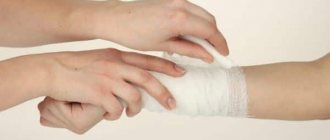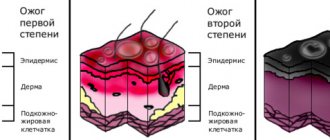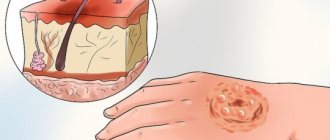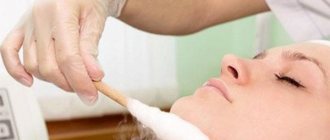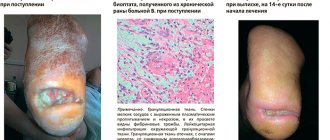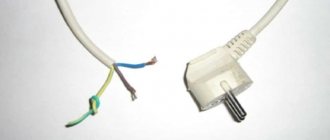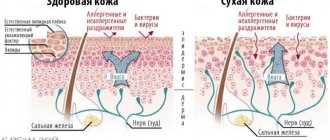Degrees and treatment of burns
Features of treatment and further regeneration of the skin will depend on the degree of the burn, its depth and size.
There are four degrees of burn:
- 1st degree burn. The outer layer of skin is damaged. As a result, there is slight redness of the epidermis and swelling, which may be accompanied by pain. Typically, burn marks disappear after 2-3 days;
- 2nd degree burn. The upper, stratum corneum layer of the skin is affected, and sometimes the next layer is damaged. Blistering, redness and pain are quite common. If you choose the right treatment method and use appropriate therapy, after 10-12 days there will be no trace of the burn;
- 3rd degree burn. It is one of the most serious skin injuries. It spreads to the deep layers of the skin, affecting the upper subcutaneous tissue. Blisters and scabs appear. The wound takes a long time to heal;
- 4th degree burn. The skin becomes charred and the subcutaneous bones are damaged. All skin layers and tissues located underneath die. In this case, immediate hospitalization will be required.
In order to properly provide the necessary assistance and not harm the victim, it is worth understanding the cause of the injury. This will not cause any difficulties if you have an idea of the types of burns:
- thermal burns can be obtained when the skin interacts with boiling water, fire, or a hot object;
- a chemical burn is caused by a chemical or alkaline agent;
- radiation burn occurs as a result of ultraviolet radiation;
- A radiation or electrical burn occurs when in contact with an electric current or a voltaic arc.
For quick healing when receiving a first-degree burn, it is important to provide first aid in a timely manner. To do this, it is necessary to urgently eliminate the cause of the burn. Cool the affected skin area with ice or cold water.
It is not recommended to immediately apply anti-burn cream or ointment to the wound. Initially, you need to clean the intact skin located in close proximity to the burn with ether, then wipe with alcohol. Sodium chloride can be used to remove dead tissue from a wound.
A victim with a severe burn, before the ambulance arrives, should be given an anesthetic, analgin, ketanal or pentalgin, and an antihistamine in the form of claritin, tavegil or suprastin. Dexpanthenol is effective for burns.
If there is no vomiting, you can drink mineral water or liquid with dissolved salt and soda with a dosage of 0.5 tsp. per liter of water.
If you receive severe burns, you should not self-medicate; you should immediately seek medical help.
What are burn scars?
A common scar is abnormally fused connective tissue with excess collagen fibers. A burn scar is a dense connective formation that also occurs during healing of an injury, but it also depends on the depth of damage to the epidermis, that is, it is not only a cosmetic problem, but often affects health issues if scars form in the extremities.
What happens to the skin during a burn?
The critical temperature at which you are guaranteed a burn is 43 C. Below, you should not be afraid of hot baths or a warm radiator on a winter evening - they are absolutely safe for you. In everyday life, you can get burned at 100-200 C by touching a hot source for no more than 1 second. In places of combat and in work shops, burns are especially dangerous and can occur at temperatures of 1000 C. You need to be very careful!
The degree of injury is influenced by its location on the body and the structure of the skin: the thermal conductivity of the dermis is higher than that of subcutaneous fat, since fat is a good insulator. Consequently, serious damage to the dermis may not affect the lower lipid layer, although too high temperatures lead to irreversible consequences: tissue, internal organs and even bones are destroyed. If first aid for a burn is not provided on time, irreversible intoxication of the body may begin.
Let's look at the degrees of burns in more detail.
Types of burns
Depending on the type, or degree, of the burn, the consequences will be of varying severity.
Typically the injury is classified into:
- superficial burns or 1st level burns;
- moderate or superficial burns of the 2nd level;
- deep - 3 levels.
A level 1 burn is the most harmless of all. Affects the upper layers of the epidermis, without reaching the dermis with hair follicles. After such a burn, there are no scars left, since enough keratinocytes come from the bottom of the follicle for normal tissue restoration.
Level 2 burn - can be superficial or deep. With a superficial burn, the entire epidermis and papillary layer of the dermis are affected, and with a deep burn, the reticular layer of the dermis is also injured. After the skin is damaged, macrophages are activated - particles that clean the wound of dead cells. Under the burned tissue, a new granulation tissue forms, which forms a scab. Thanks to this, the epidermis “heals” and a normotrophic scar appears (a scar that does not require correction).
However, if an infection gets into the wound during recovery, the rehabilitation stage may be delayed and a keloid or hypertrophic scar will form!
Level 3 burn - not only the epidermis is injured, but also the dermis, and subcutaneous fat with hair follicles. The latter are completely destroyed, which has a primary effect on wound healing. Since the hair follicles at the burn site are destroyed to the ground, keratinocytes come only from the edges of the wound, which is why rehabilitation is extremely slow.
Important! The longer the wound heals, the higher the likelihood of infection getting into it, which means the formation of keloid or hypertrophic scars that require immediate correction.
What is a keloid scar?
A keloid scar is often confused with a hypertrophic one. The difference is that, unlike a hypertrophic scar, a keloid scar brings a lot of discomfort: it quickly increases, growing beyond the wound, is accompanied by itching and pain, and has a bright burgundy or bluish color. The keloid scar does not shrink or resolve on its own, therefore, to get rid of it, you need to undergo several courses of physiotherapy with special means. It grows quite quickly and can extend beyond the burn in the form of peripheral cords.
The keloid scar itself does not shrink and does not resolve. To get rid of the scar after a burn, you will need to undergo a course of procedures.
Read more in our article:
Treatment of keloid scars
What is a hypertrophic scar?
Unlike a keloid, it does not extend beyond the burn, but there is definitely nothing good about it. This defect is caused by excess collagen fibers at the burn site, which means it is dense and located above the skin level. Just like a keloid scar, it is not able to resolve on its own and requires treatment. Being in the area of the joints, such scars cause the greatest trouble, interfering with the normal functioning of the limbs.
Hypertrophic and keloid scars occur with deep burns, that is, with stages 2 or 3 or if the burn is very large. In affected areas, skin pigmentation is disrupted - it may be darker or lighter than the overall tone.
Sometimes scars grow in size over six months and then decrease over several years, but this is a rather rare occurrence in medical practice.
Factors that increase the likelihood of developing a burn scar
During recovery from injury, the effects can manifest themselves in many different ways. It depends on the:
- Patient's age . Children and adolescents have delicate skin, which means the risk of being left with a scar and burn mark is higher, but at the same time it recovers faster, because the regenerative features of the skin are better developed than in an adult.
- Women are more prone to scars after burns than men.
- Injuries on the neck and upper extremities are hard-to-reach places that are more difficult to treat; the skin there is less elastic, which means less elastin is produced, and cell regeneration occurs more slowly.
- Surgery at the burn site more than once is often not a good solution, as it increases the risk of recurrence (re-formation of scars).
- Transplantation of a mesh skin flap at the burn site.
- It has been observed that dark-skinned people and people with Asian appearance are more prone to the formation of keloid scars due to their skin characteristics.
Properly selected treatment and cosmetics will eliminate unwanted consequences.
Skin restoration
After a burn, a blister containing a colorless liquid may form on the skin. Its proper treatment will help avoid an inflammatory and purulent reaction. Under the neoplasm there will be a renewed skin layer; after 8-10 days, the damaged part will dry out and fall off.
In place of the blister, new skin will appear in the form of a pink spot. The renewed skin area is usually very sensitive, so it is recommended to treat it with special creams and ointments that promote effective and safe recovery.
Failure to provide first aid in a timely manner can lead to disappointing consequences. An infection will appear at the burn site, the resulting blister will become inflamed and begin to fester. The phenomenon usually entails fever, poor health, chills and weakness. The wound will heal slowly and recovery may take too long. In order to avoid serious complications, you should not hesitate, you need to urgently contact a specialist, who, in turn, will conduct tests and prescribe the correct treatment.
Severity
This type of burn can vary in severity. Single redness or abrasions are possible, and, in addition, damage to several layers of skin at once with open bleeding and painful wounds. In most situations, carpet burns can be treated at home. But if the wound becomes infected, or the damage covers a large area of the body, you should consult a doctor.
Treatment of post-burn scars and scars
The scar that appears at the burn site can sometimes become inflamed and form a keloid scar, which is accompanied by severe
itching. Large scars left after a burn injury are treated with surgery. It is possible to get rid of a post-burn scar by excision of the scar, onto which a cosmetic suture is subsequently applied. After its removal, the resulting scar is treated with medications to promote rapid healing.
Scars that occupy a small area can be removed by laser resurfacing; chemical peeling based on fruit acids can also be used. For a quick regeneration process, it is additionally advisable to use special ointments and gels.
What to do next?
Next, cover the carpet burn with an adhesive bandage or bandage. You can remove the bandage and check the wound after twenty-four hours. If scabs (crusts) begin to appear on the skin surface, this means that the healing process of the burn is going well, that is, it is no longer necessary to cover it; it can come into contact with air. But if the skin is still red and oozing and no crusts have formed, a fresh bandage should be applied for another day.
Remedies for burns
Today, there are many types of medications for burns in the form of gels, ointments, sprays, creams and dressings.
For example, Levomekol helps well with thermal burns. The drug has bactericidal properties, thanks to which the injury heals much faster. Moreover, the constituent components are substances that help relieve pain.
Povidone-iodine ointment contains iodine. The chemical element disinfects the site of damage and promotes the rapid restoration of skin tissue. Balm Rescuer, made from natural ingredients, can restore damaged skin to a healthy appearance in the shortest possible time.
The creams have also actively proven themselves in the treatment of burns, which are used at the recovery stage of damaged tissue areas. They can be used for preventive purposes against the formation of scars. Panthenol cream helps well with thermal and sunburn.
Providing first aid for carpet burns
As part of first aid, the following actions should be taken:
- It is necessary to wash your hands before treating a burn. Any of them damages the skin, which is the main base of defense of the human body. Infection can easily enter the body through abrasions and burns. How to treat a burn at home, we will consider below.
- The next step is to clean the damaged area. You need to wash the burn very carefully, using a clean, soft washcloth and warm water, and it is also advisable to use antibacterial soap. Using the above tools, you need to remove all visible debris and dirt, which will certainly help prevent the occurrence of infection.
- After cleansing, the wound should be disinfected. In this case, thorough treatment with alcohol, hydrogen peroxide or iodine is suitable - this is especially necessary if there are signs of dirt on the abrasion or bleeding continues. You need to dip a cotton swab in iodine, alcohol or peroxide, and then blot the carpet burn with it. This procedure may be slightly painful. The use of alcohol can be harmful, and in addition, cause extremely unpleasant sensations, so it should be used or an alcohol iodine tincture only in extreme cases.
Chemical burns to the eyes: treatment
First aid consists of flushing the eyes with plenty of running water for 10 minutes and applying a gauze bandage. To avoid complications, consultation with an ophthalmologist is necessary. The effects depend on the type of substance, its concentration, volume and aggressiveness.
Important: proper and timely qualified care for burns will help the patient restore the affected skin as quickly and painlessly as possible. Contact the medical center. Experts will help in any situation and tell you what to do if red spots similar to hogweed burns occur. You can sign up for a consultation on the website and by calling the above phone numbers.
Related services: Consultation with a dermatologist Emergency call
What is prohibited to do
When providing first aid immediately after a burn has occurred, it is strictly forbidden to use fatty-based oils and ointments. They create a film on the skin that prevents heat from dissipating, causing thermal damage to worsen and the wound to become deeper.
When treating leather, do not use products containing alcohol. Once a scab appears on the burn, the risk of damage from alcohol is minimal. But given the choice and availability of safe antiseptics without alcohol, it is better to use them at all stages of treatment.
The main rule for treating a wound is not to injure it further. Therefore, patches or cotton wool should not be used. It will be difficult to tear them away from the wound, due to which the damaged tissues will be injured during each dressing.
Providing first aid
Eliminating the source of damage is the first priority when providing assistance. If clothing is on fire, you must remove it as quickly as possible or throw a blanket or blanket over the victim. This will cut off the access of oxygen to the fire. The second stage is to free the damaged areas from clothing. This should be done easily, without effort.
Cooling the affected area. Relevant for mild burns. When providing first aid for a deep burn with hot steam, this should not be done.
Closure (isolation) of the burn surface. This can be done using a gauze bandage, which is applied as easily as possible to avoid irritation of the wound and increased pain.
Pain relief is carried out with tablets and injections.
Hospitalization. The victim must be taken to a medical facility as quickly as possible. Especially when it comes to a burn to the cornea of the eye due to welding.
What you should absolutely not do:
- treat the surface of the burn with improvised means;
- treat the wound without anesthesia and sterile dressings;
- do not puncture blisters from burns;
- use a tourniquet;
- remove stuck clothes.
On our website you will find more specific recommendations for first aid, including what adults should do if a child is burned by boiling water.
Prevention
Burns can be avoided by carefully following safety precautions. It is possible to protect children from thermal and chemical damage if they are not allowed to be near sources of potential danger (household chemicals, stove, stove). Areas where hazardous substances are stored must be closed and chemicals must be placed on the highest shelf or in a locked cabinet.
You should always have medicines at home to provide first aid after a burn: special wipes, alcohol-free antiseptics, aerosols for skin regeneration.
Features of providing assistance to children
Unfortunately, burns in children occur frequently. When helping parents, there are some things to keep in mind:
- when cooling the affected surface, the baby should be well wrapped, avoiding general hypothermia;
- a sterile dressing must be applied as lightly as possible to avoid increased pain;
- you can use Panthenol spray, which helps against sunburn and household burns;
- under no circumstances should you puncture the resulting bubble;
- The baby should be given soothing drops and antihistamines.
After providing first aid, you should call an ambulance. Many parents are interested in the question: “is it possible to smear Levomekol on a burn?” Doctors recommend using the ointment twice a day for two weeks.
Finalgon and its action
Finalgon is an anesthetic based on the components niobsil and nonivamide.
These substances penetrate deep into the inflamed tissues and act as distracting stimuli to eliminate the feeling of pain (partially or completely).
This drug is prescribed for joint pain, sprains, bruises and other injuries to soft tissues and muscles .
The active components of finalgon are derivatives of alkalis of plant origin.
Acting directly on the deep layers of soft tissue, when used correctly, these components do not injure the surface layer of the skin.
For your information! The resulting burning sensation is always present, and in the worst case (with regular use of the ointment and applying it in large quantities), the product even leaves chemical burns.
Stellanin
The ointment is intended for the treatment of first and second degree burns, as well as mechanical damage to the epithelium, trophic ulcers, postoperative wounds, etc. The active ingredients of the drug are diethylbenzimidazolium triiodide, dimethyl sulfoxide, iodine, purified petroleum jelly.
Stellanin ointment
Stellanin has a disinfecting and antibacterial effect, prevents the appearance of pathogenic microflora and accelerates the healing process. This is a well-proven remedy, but it has many serious contraindications that you should definitely familiarize yourself with.
